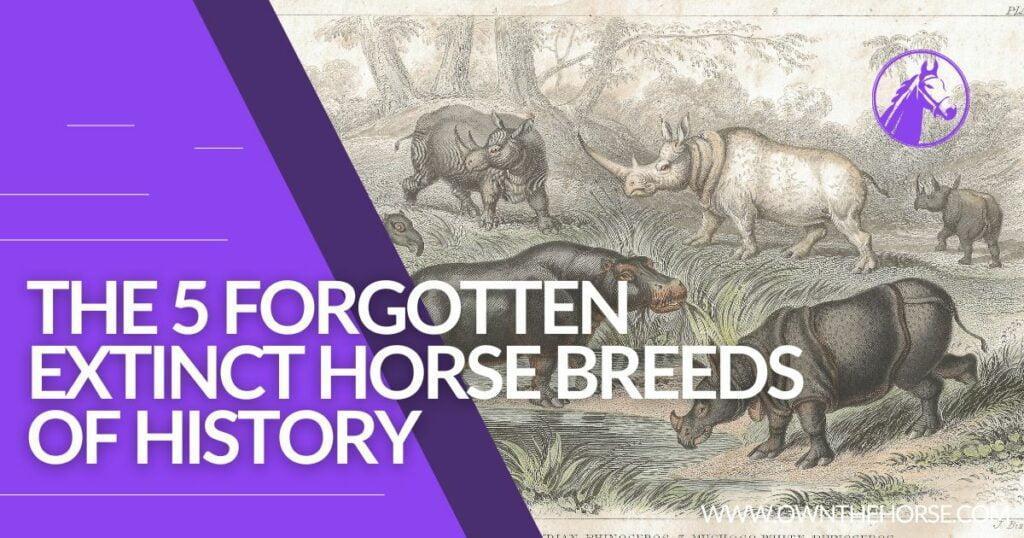As an Amazon Associate we earn from qualifying purchases.
The horse has been a beloved part of our history, and many of us remember the different breeds of horses that used to exist. Sadly, some of these breeds have become extinct over time due to over-hunting, habitat loss, and hybridization.
Here, we take a look back at five horse breeds that were once prominent in their respective regions, but are now lost to the annals of history. From the Tarpan of the Eurasian steppe to the Irish Hobby of Ireland, these five breeds were once integral parts of their regions and are now remembered only by those who still recall them in stories or pictures. Join us as we take a look back at the five forgotten extinct horse breeds of history.
The Tarpan
The Tarpan was a hardy, rugged horse that was adapted to the harsh environment of the Eurasian steppe. It had a thick mane and tail, and a short, strong neck. Its coat could range from gray to dun to bay, and sometimes had a dorsal stripe. Its legs were short but powerful, and its hooves were well adapted for hard ground.
The Tarpan was also known for its intelligence and quick reactions, which made it a reliable mount for nomadic peoples of the area. It was also used as a draft animal, with some able to pull heavy loads for long distances across the steppe.
The Tarpan was believed to be the ancestor of many modern horse breeds, such as the American Mustang and the European Konik.
Why Did The Tarpan Go Extinct?
Unfortunately, this breed went extinct in the late 19th century due to over-hunting and hybridization with domestic horses. It is believed that the Tarpan was hunted for its meat, fur, and hide, and that hybridization with domestic horses led to the dilution of their gene pool and eventually their extinction. The Tarpan is now remembered only in stories and pictures, but its legacy lives on in the modern horse breeds that descended from it.
The Bos Primigenius
The Bos Primigenius had a coat that varied in color from a dark brown to a rusty red. Its mane and tail were long and often wavy, and its legs were short and sturdy. This ancient horse was well adapted to cold climates, with a thick coat to keep it warm in the winter. Its hyoid bone was also thicker than that of the modern horse, allowing it to have a louder and more powerful call.
The Bos Primigenius was an important animal in the lives of early humans, being used as a food source and for transportation. In some cases, these horses were even domesticated by early humans, though it is unclear if these domesticated horses left any genetic traces in modern breeds.
In addition to its role in human history, the Bos Primigenius also had a major impact on the environment. They grazed on a variety of vegetation, including grasses, herbs, and shrubs, and their grazing habits had a significant effect on the landscape.
Why Did The Bos Primigenius Go Extinct?
Unfortunately, this breed went extinct around 12,000 years ago, likely due to climate change and the extinction of its primary food source. It is believed that the extreme changes in the climate caused the food sources of the Bos Primigenius to become scarce, leading to their eventual extinction. This breed is now remembered only in stories and pictures.
The Caspian Horse
The Caspian Horse was a small but sturdy breed, standing at an average of 12.2 hands high. It had a short, angled head with a straight profile, small ears, and a short neck. Its body was compact with sloping shoulders and a deep chest, and its legs were strong and well-muscled. Its coat was usually bay, black, or chestnut, but it could also be gray, roan, or white.
The breed was known for its intelligence, speed, and agility, and was used for riding, racing, and light draft work. It was favored in the Middle East for its quickness and agility, and was bred for centuries by Persian and Iranian royalty to be a superior riding mount. The breed was also used in the military and in hunting.
In the late 19th and early 20th centuries, the Caspian Horse was exported to England, where it was successfully bred and its influence is still seen in some modern breeds. It was also taken to the United States, where it gained popularity as a riding horse and as a show horse.
Why Did The Caspian Horse Go Extinct?
This breed went extinct in the early 20th century due to over-hunting and increasing urbanization. It is believed that the Caspian Horse was hunted for its meat and hide, and that the increasing urbanization of its native region caused its habitat to shrink and its population to dwindle.
The Irish Hobby
The Irish Hobby was a small, hardy horse that originated in Ireland. It was a versatile breed, used for both riding and packing, and had a reputation for being intelligent and athletic. The breed was known for its endurance, and could carry a heavy load for long distances. Its small size meant that it could maneuver in tight spaces, and its strength and agility made it well suited for farm work, such as plowing and hauling. The Irish Hobby was also used in sports such as racing, jumping, and dressage.
The breed was primarily bred in Ireland and the United Kingdom, and was popular among farmers and gentry alike. The Irish Hobby was known for its gentle temperament and was a favorite children’s pony. The breed was also sometimes crossed with other horses to create new breeds, such as the Connemara Pony.
Why Did The Irish Hobby Go Extinct?
This breed went extinct in the mid-19th century due to hybridization with other breeds. It is believed that the Irish Hobby was hybridized with other breeds in order to create a more hardy, versatile breed. This hybridization led to the eventual extinction of the Irish Hobby.
The Norfolk Trotter
The Norfolk Trotter, a breed of draft horse, was developed in Norfolk, England in the late 19th century. Its primary use was as a heavy carriage horse, and it was also used for farm work, such as plowing and hauling. The breed is noted for its strength and stamina, and was widely used in all types of agricultural work. The breed was popular in England, but also exported to many countries, including the United States. The breed is thought to have been a cross between the Norfolk Roadster and the Suffolk Punch.
The Norfolk Trotter was a large horse, with a compact, muscular body. It stands between 15 and 17 hands high, and typically weighs between 1,200 and 1,600 pounds. The horse has a deep chest, short back, and strong, muscular hindquarters. Its legs are short and strong, and the hooves are large and tough. The head is short and blunt, with large, expressive eyes. The mane and tail are long and thick. The Norfolk Trotter had a smooth, trotting gait.
Why Did The Norfolk Trotter Go Extinct?
This breed went extinct in the late 19th century due to crossbreeding with other draft horses. It is believed that the Norfolk Trotter was crossed with other draft horses to create a stronger and more powerful breed, leading to the eventual extinction of the Norfolk Trotter. This breed is now remembered only in stories and pictures, but its legacy lives on in the modern draft horses of today.
Extinct Horse Breeds – Why Does It Happen?
As with any species, the risk of extinction is always present, and horse breeds are no exception. Unfortunately, some breeds of horses have gone extinct due to a variety of factors, ranging from human interference to environmental changes. Here are some of the main factors that have contributed to the extinction of certain equine breeds.
1. Human Interference: Humans have been selectively breeding horses for centuries, and, as a result, some breeds have gone extinct. Some breeds, such as the Cleveland Bay, were bred for specific purposes, such as racing or draft work, and when those purposes became obsolete, the breed went extinct. Other breeds, such as the Norfolk Trotter, were bred for their beauty and were no longer desired when fashion trends changed.
2. Natural Disaster: Natural disasters, such as floods, fires, and droughts, can have a devastating effect on horse populations. These disasters can wipe out entire herds, leading to the extinction of a breed.
3. Disease: Disease outbreaks can also cause a breed to go extinct. For example, the Hokkaido horse was wiped out due to an outbreak of a fatal disease.
4. Environmental Changes: Climate change has been known to cause the extinction of certain breeds. For example, the Arabian horse was unable to survive in the more arid climates of the Middle East and became extinct.
5. Lack of Resources: Another factor that can lead to extinction is the lack of resources available to sustain a breed. For example, some breeds, such as the Norfolk Trotter, require large amounts of forage and can be difficult to sustain in areas where food is scarce.
Although some horse breeds have gone extinct, there are still many breeds that are thriving today. It is important to recognize the factors that led to the extinction of certain breeds and to ensure that the same mistakes are not made in the future. By preserving the genetic diversity of equine breeds, we can ensure that future generations will be able to enjoy the beauty and grace of the horse.
How and Where to Shoot a Horse to Put it Down?
Amazon and the Amazon logo are trademarks of Amazon.com, Inc, or its affiliates.

Hey there, I’m Jasmine! I’m a total horse fanatic and have been working with these amazing animals for as long as I can remember. I’m passionate about sharing my love for horses with others and helping them learn more about these majestic creatures. As a professional horse trainer and riding instructor, I’ve developed a deep understanding of equine science and am committed to the welfare of horses. That’s why I founded OwnTheHorse.com, a blog where I share my knowledge and insights with fellow horse enthusiasts. I love connecting with my readers and building a friendly community of horse lovers. Whether you’re a seasoned equestrian or just starting out, I’m here to help and inspire you. Above all, I’m a friendly and compassionate person who truly cares about the well-being of horses and their human companions.

